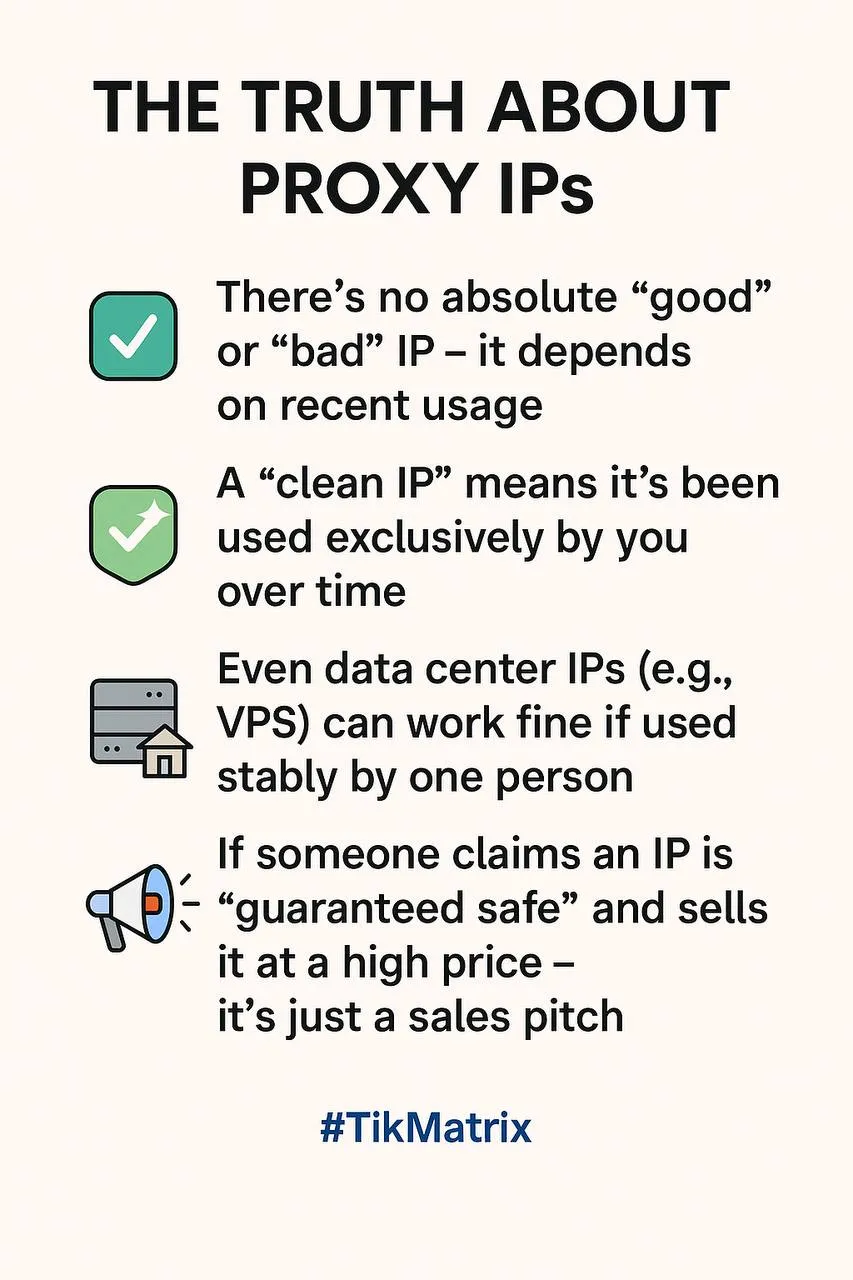The Truth About Proxy IPs for TikTok Operations
Running TikTok at scale and confused by “clean IP” vs “bad IP”?
This guide explains what actually matters: recent usage patterns, isolation, and stability — not marketing buzzwords.

🧠 1. What “Clean IP” Really Means
“Clean” isn’t a label you buy — it’s a state you maintain.
- A clean IP is one that has been used only by you over time
- No abuse history (spam, mass registrations, brute force)
- Consistent geography, ASN, and stable behavior signals
Key idea: Cleanliness is temporal + behavioral, not a magic IP range.
🧪 2. Usage Patterns > IP Type
Even data center IPs can work — if usage is consistent and isolated.
| Factor | Good Pattern | Risky Pattern |
|---|---|---|
| Ownership | Dedicated to one operator | Shared across many users |
| Behavior | Human-like cadence, staggered tasks | Synchronized mass actions |
| Geography | Stable region / timezone | Frequent country hopping |
| Session length | Steady, long sessions | Short bursts, many accounts |
| Device mapping | Fixed phone ↔ proxy pairs | Random proxy rotation |
Stability beats labels. Your behavior shapes the IP’s reputation.
🏢 3. Residential vs Datacenter: Myths vs Reality
| Type | Reality Check | Works When |
|---|---|---|
| Residential | Often trusted by default, but can be abused via resale pools | Dedicated / sticky, one device per IP |
| Datacenter (VPS) | Not “evil”; just more scrutinized | Long-term, single-tenant usage |
| Mobile (4G/5G) | Rotates NAT pools; good for browsing, noisy for identity | Controlled rotation + session pinning |
Conclusion: All types can work — if isolated and consistent.
🧰 4. Building Your Own “Clean IP” the Right Way
- Use dedicated proxies (not shared pools)
- Pin one device per IP (or stable small group)
- Keep region/timezone/locale aligned with your content strategy
- Warm up gradually (search, watch, like) before heavy actions
- Log IP history: ASN, city, first-use date, devices mapped
If your provider “guarantees safe IPs,” treat it as a sales pitch, not a control strategy.
📈 5. Practical Health Checks
- Verify IP geo and ASN before each session (e.g., ipinfo-like checks)
- Track drop/ban events per IP; remove outliers from rotation
- Watch for sudden captcha spikes → indicates reputation stress
- Use long-lived sessions; avoid excessive reconnects
🧨 6. Common Pitfalls That “Dirty” an IP
- Mass registration from one subnet in a short window
- Same caption/hashtag patterns across many accounts
- Overusing public/shared VPNs with unknown neighbors
- Rotating proxies on every request (non-human pattern)
- Country hopping without matching device locale & content
💸 7. Cost vs Value
High price ≠ safety. Value comes from:
- Exclusivity (you’re the only user)
- Consistency (fixed mapping, stable behavior)
- Observability (logs, alerts, reputation checks)
Pay for control and isolation, not for buzzwords.
✅ 8. Risk Control Checklist (Proxies)
| Category | Recommendation |
|---|---|
| Isolation | Dedicated IPs, one device ↔ one IP |
| Consistency | Stable region/ASN; avoid frequent hops |
| Behavior | Human-like cadence; staggered tasks |
| Telemetry | Log bans/captchas per IP; track reputation |
| Rotation | Slow rotation with session pinning; avoid per-request |
| Compliance | Align locale/timezone/content to audience |
⚡ Why TikMatrix Helps Here
- 🎛️ Per-device proxy binding and stable session control
- 🕒 Staggered schedulers to avoid synchronized spikes
- 🧠 Human-like automation (typing, swipes, delays)
- 📊 Action logging to correlate bans with IP/device history
🏁 Conclusion
There’s no absolute “good” or “bad” IP.
Stability + Isolation beat premium price tags every time. Build your own “clean IP” via consistent, exclusive use — and keep it clean with disciplined operations.
This article reflects real-world tests across residential, datacenter, and mobile proxies in long-running, production-like environments.
